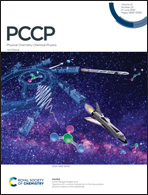Competition between tubular, planar and cage geometries: a complete picture of structural evolution of Bn (n = 31–50) clusters†
Abstract
Stimulated by the early theoretical prediction of B80 fullerene and the experimental finding of the B40 cage, the structures of medium-sized boron clusters have attracted intensive research interest during the last decade, but a complete picture of their size-dependent structural evolution remains a puzzle. Using a genetic algorithm combined with density-functional theory calculations, we have performed a systematic global search for the low-lying structures of neutral Bn clusters with n = 31–50. Diverse structural patterns, including tubular, quasi-planar, cage, core–shell, and bilayer, are demonstrated for the ground-state Bn clusters; for certain cluster sizes, unprecedented geometries are predicted for the first time. Their stabilities at finite temperatures are evaluated, and the competition mechanism between various patterns is elucidated. Chemical bonding analysis reveals that the availability of localized σ bonds and delocalized π bonds in the Bn clusters play a key role in their structural stability. Our results provide important insights into the bonding pattern and growth behavior of medium-sized boron clusters, which lay the foundation for experimental design and synthesis of boron nanostructures.

- This article is part of the themed collection: 2020 PCCP HOT Articles


 Please wait while we load your content...
Please wait while we load your content...